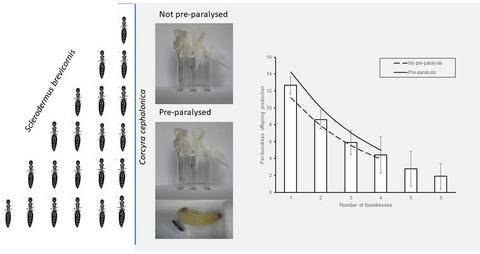当前位置:
X-MOL 学术
›
Entomol. Exp. Appl.
›
论文详情
Our official English website, www.x-mol.net, welcomes your
feedback! (Note: you will need to create a separate account there.)
Performance of Sclerodermus brevicornis, a parasitoid of invasive longhorn beetles, when reared on rice moth larvae
Entomologia Experimentalis et Applicata ( IF 1.4 ) Pub Date : 2020-07-05 , DOI: 10.1111/eea.12946 Mohamed Khadar Abdi 1, 2 , Costanza Jucker 3 , Beatrice De Marchi 3 , Ian C.W. Hardy 1 , Daniela Lupi 3
Entomologia Experimentalis et Applicata ( IF 1.4 ) Pub Date : 2020-07-05 , DOI: 10.1111/eea.12946 Mohamed Khadar Abdi 1, 2 , Costanza Jucker 3 , Beatrice De Marchi 3 , Ian C.W. Hardy 1 , Daniela Lupi 3
Affiliation

|
Biological control efficiency can be improved by developing effective mass‐rearing systems to produce large numbers of high‐quality parasitoids. This study explored an alternative host for rearing Sclerodermus brevicornis (Kieffer) (Hymenoptera: Bethylidae), a potential biocontrol agent for the suppression of exotic and invasive wood‐boring longhorn beetle (Coleoptera: Cerambycidae) populations in the European agroforestry ecosystems. We tested larvae of the rice moth, Corcyra cephalonica Stainton (Lepidoptera: Pyralidae), as host for the parasitoid. We quantified the probability and timing of host attack and parasitism as well as reproductive success, offspring production, and the characteristics of adult offspring. As S. brevicornis is a quasi‐social species (multiple females, communally produced offspring broods), we also explored the effects of varying the number of females to which individual hosts were presented, with the aim of determining the optimal female‐to‐host ratio. As time to host attack can be a limiting factor in S. brevicornis rearing protocols, we tested the use of adult females of another bethylid species, Goniozus legneri Gordh, to paralyse C. cephalonica larvae prior to presentation. We identified the conditions within our experiment that maximized offspring production per host and offspring production per adult female parasitoid. We found that C. cephalonica is suitable as a factitious host and, as it is considerably more straightforward for laboratory rearing than cerambycid species, it is a good candidate for adoption by future S. brevicornis mass‐rearing and release programmes.
中文翻译:

Sclerodermus brevicornis,一种侵入性长角甲虫的寄生物,在稻蛾幼虫上饲养时的表现
通过开发有效的大规模饲养系统来生产大量高质量的寄生蜂,可以提高生物控制效率。本研究探索了用于饲养短角硬皮病(Kieffer)(膜翅目:Bethylidae)的替代宿主,这是一种潜在的生物防治剂,用于抑制欧洲农林业生态系统中的外来和侵入性钻木长角甲虫(鞘翅目:天牛科)种群。我们测试了稻蛾 Corcyra cephalonica Stainton(鳞翅目:Pyralidae)的幼虫作为寄生蜂的宿主。我们量化了宿主攻击和寄生的概率和时间,以及繁殖成功、后代生产和成年后代的特征。由于 S. brevicornis 是一种准社会物种(多雌性,共同产生的后代),我们还探讨了不同宿主出现的雌性数量的影响,目的是确定最佳雌性与宿主的比例。由于宿主攻击的时间可能是 S. brevicornis 饲养协议中的一个限制因素,我们测试了使用另一种 bethylid 物种 Goniozus legneri Gordh 的成年雌性在演示之前麻痹 C. cephalonica 幼虫。我们确定了在我们的实验中最大化每个宿主的后代产量和每个成年雌性寄生蜂的后代产量的条件。我们发现 C. cephalonica 适合作为人工宿主,并且由于它比天牛属物种更易于实验室饲养,因此它是未来 S. brevicornis 大规模饲养和释放计划采用的良好候选者。
更新日期:2020-07-05
中文翻译:

Sclerodermus brevicornis,一种侵入性长角甲虫的寄生物,在稻蛾幼虫上饲养时的表现
通过开发有效的大规模饲养系统来生产大量高质量的寄生蜂,可以提高生物控制效率。本研究探索了用于饲养短角硬皮病(Kieffer)(膜翅目:Bethylidae)的替代宿主,这是一种潜在的生物防治剂,用于抑制欧洲农林业生态系统中的外来和侵入性钻木长角甲虫(鞘翅目:天牛科)种群。我们测试了稻蛾 Corcyra cephalonica Stainton(鳞翅目:Pyralidae)的幼虫作为寄生蜂的宿主。我们量化了宿主攻击和寄生的概率和时间,以及繁殖成功、后代生产和成年后代的特征。由于 S. brevicornis 是一种准社会物种(多雌性,共同产生的后代),我们还探讨了不同宿主出现的雌性数量的影响,目的是确定最佳雌性与宿主的比例。由于宿主攻击的时间可能是 S. brevicornis 饲养协议中的一个限制因素,我们测试了使用另一种 bethylid 物种 Goniozus legneri Gordh 的成年雌性在演示之前麻痹 C. cephalonica 幼虫。我们确定了在我们的实验中最大化每个宿主的后代产量和每个成年雌性寄生蜂的后代产量的条件。我们发现 C. cephalonica 适合作为人工宿主,并且由于它比天牛属物种更易于实验室饲养,因此它是未来 S. brevicornis 大规模饲养和释放计划采用的良好候选者。











































 京公网安备 11010802027423号
京公网安备 11010802027423号